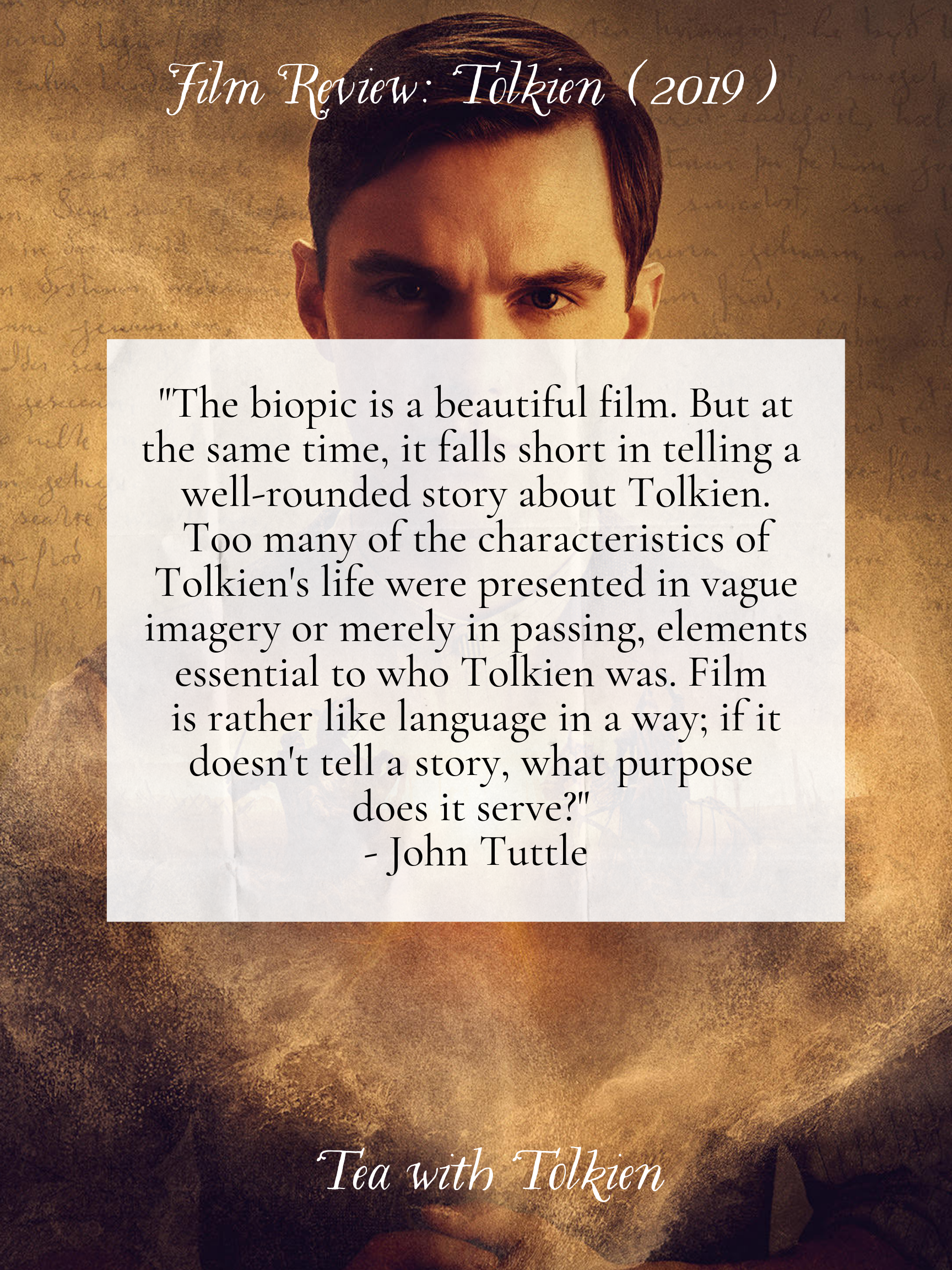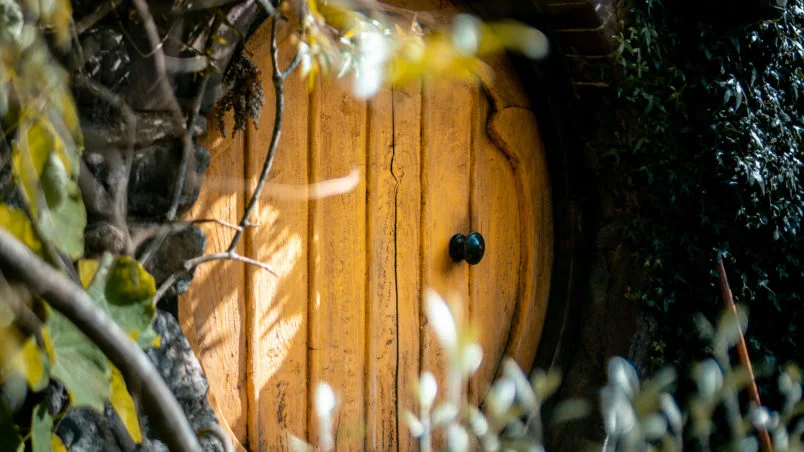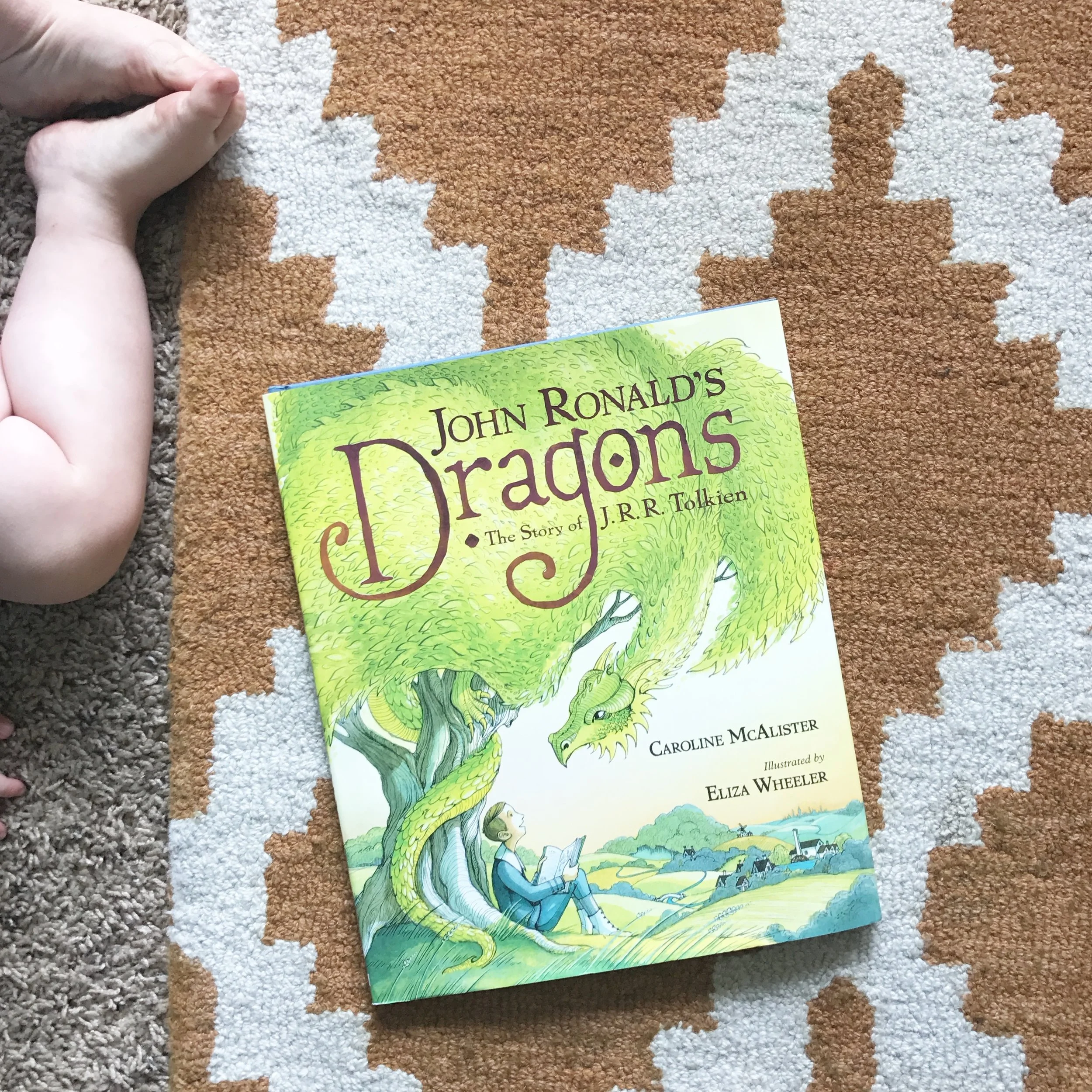Film Review: Tolkien (2019)
Now that the Tolkien biopic is available to download and stream online, I wanted to share this review of the film written for the Tea with Tolkien blog by John Tuttle. I’d love to hear your thoughts on the film! Warning: this review contains spoilers.
Tolkien (2019) Misses Some of Tolkien But Presents Beauty of Friendship, Love, and Creativity
When watching a non-fiction biographical film, there are two separate and fundamental questions which deserve to be asked – and answered. First off, does the film present genuine characters, a decent plot, and inevitably an entertaining product? High standards, yes. But cinema is an art form, and these points are just as good as any to begin a critique. Secondly, and primarily in regard to non-fiction productions, does the film portray historical events and figures accurately?
This latter question carries its weight in that it ultimately seeks to know whether or not a modern feature film can convey a historical story with authenticity and in reality. Karukoski's Tolkien (2019) provides answers to both questions, though it does not completely satisfy the latter. This review contains spoilers.
Highlights of the Movie
The movie itself is beautifully filmed. The cast assembled under this Dome Karukoski production consists of veteran movie stars as well as new, young acting talent. When combined, they deliver a convincing British gathering of the early 20th century era. Stars such as Nicholas Hoult from Jack the Giant Slayer and Owen Teale of Game of Thrones come together to bring the life events of J.R.R. Tolkien to the big screen, in a way honoring the man whose work partially influenced those on-screen adventures which they became known for. Other notable performances are seen from Lily Collins (To the Bone) and Derek Jacobi (Gladiator).
As for up and coming acting talent, Anthony Boyle's portrayal of Geoffrey Smith was both well-written and splendidly performed. Robert Gilson is a another character who we see develop. His breakthrough comes in achieving a backbone. But Robert is also the close companion of Ronald who is most inclined to foolhardiness. He is boisterous, rowdy, comical, and ever ready to jump into adventure. His is a character who possesses a slightly bigger-than-life personality. Albie Marber plays the more youthful Robert stupendously. Spot on. Additionally, fellow actor Patrick Gibson provides a fine, rewarding take on Robert Gilson as he is situated in a more mature body and mindset.
Two of the key elements feeding into young Tolkien's own character are love of friendship and love of creativity. Ronald's little club of creatives, the T.C.B.S. (Tea Club and Barrovian Society), is the chief exemplar of this welcomed inclusion of creative flare – at least in the film. Here, in this warm and benevolent atmosphere of support and constructive criticism, of nicetis and jollility, Tolkien and his friends get to pursue their dreams. Here, amongst friends, dreams get turned into something tangible.
The most emotional element to Tolkien was certainly the death of his best friend Geoffrey Smith, the man who always had Ronald's back, who was often there for moral support, who always there with an inviting smile. In viewing the film, I did not tear up for Tolkien. I teared up for myself in my own loss. I lost the kindest friend back in 2017; he was killed in a hiking accident. But he was the most open-minded, inviting, and joy-filled man I can recall knowing. If he saw someone off by themselves at a party or gathering, he would be the guy to approach them and invite them into his inner circle of friends.
In the movie, when Tolkien consoles Geoffrey's mom by telling her what kind of person her son was, a man who knew what it means to love and to be loved, I could not help but reminisce of my deceased friend. For all too often I was that guy who stood in a corner, not knowing what to say or how to act. And that friend singled me out and always managed to include me. He was the Geoffrey Smith in my life. I think one can be found in everyone's life. And when you find him, cherish and protect him, for friends like this are hard to come by and can never be replaced.
Tolkien's love life with Edith features a number of enticing highs and lows. In one of the deepest pangs of loss, Edith's letter informing Ronald of her engagement to another man, it is Geoffrey who helps him through it. On a brighter note, the long dolly-out scene where Edith and Ronald are entangled in a passionate kiss while listening to the play is one of the more tender moments. However, it is when the two start walking their separate ways: Tolkien toward war, Bratt toward her fiance, that the most love-infused interaction takes place. Both begin to turn away. More than that, they start walking and continue. But each thinks of what they are doing, and each concludes that they were made for each other. They go running back into each other's arms, caressing and kissing one another. Theirs is a unique and magical love.
The only problem with it thematically is this: If you know the story of Tolkien, you know who he marries. Going into the movie, someone familiar with Tolkien is likely aware of the relationship bewteen Edith Bratt and J.R.R. Tolkien. Half the people going to see the movie are aware that the two get married. Therefore, the supposed drama between them is only half as suspenseful than if the audience was more in the dark in regard to what the outcome of the relationship is going to be. But, as a loose biopic, this fact can't be helped. Suffice it to say that the relationship might have been put on the screen with a flare more romance without losing too much historical accuracy.
Perhaps most important note to make on the author's biopic is that it does not even come close to abusing the author's work in those moments where his real-life events overlap the fantastical ones. The trailer alluded to a movie which promised to be more like the loose Charles Dickens biopic The Man Who Invented Christmas (2017). However, it had few to no resemblences to the plot devices employed in that previous biopic. It was nice that the plot of Tolkien was unlike The Man Who Invented Christmas in that it did not bombard the real world with the fantasies dreamt up by the author – as was the case with the prior production.
What the Movie Butchered and Neglected about Tolkien
While the movie does a good job in detailing a number of aspects of Tolkien's early life that go on to weeve their way into The Hobbit, The Lord of the Rings, and the other Middle-earth tales, Tolkien almost completely removed any mention of another foundational dimension to Ronald's life. In addition to language, his wife, and his interest in nature, Tolkien was a man of deep faith. A devout Catholic, he himslef once noted how his faith had a significant impact on his literary works.
This aspect to his literature has been confirmed by scholars and critics including Joseph Pearce, Jonathan Witt, Jay Richards, William Ready, and others. Yet, this movie distills the presence of the Catholic faith in Tolkien's life to something that was partially a necessity of custom and partially a burden he wishes to be rid of.
The way the film is set up, a good deal of Tolkien's family life gets skimped. He goes from war-torn vet to married with a couple of kids seemingly overnight. Also, there seems little hope in his own future. The only developing hope we see is the beginnings of the story which would eventually make him famous. But this has no bearing on his immediate future. The only friends of his – that we the audience were introduced to – were almost entirely wiped out, absent from Tolkien's day-to-day life. His career as a professor is also something to be left up to the audience's imagination. A wedding between Edith and Ronald is wholly nonexistant as is the visible expression of a deep marital bond. The movie seems less about Tolkien himself than it is about conveying emotion and advocating for the admirable ideology of following one's dreams. As far as biopics go, it was lacking in a number of departments.
What the Movie Got Right about Tolkien
John Ronald Reuel Tolkien was a brilliant man, and as the movie acutely and accurately displayed, one who was quite dedicated to language, having in the course of his life thoroughly familiarized himself with Latin, Greek, French, Finnish, Old Norse, Middle English, and 20 other languages. Of course, we get a taste of the youthful Tolkien's handle on a few of these: Latin and Finnish in particular.
Beyond this, we get a glimpse into another, more creative side of Tolkien's talented mind. Specifically, I'm referring to his doodles. The man is seen sketching even more than Chris Evans' Steve Rogers in the MCU. And this is true to the person Ronald was. A brilliant philologist and a gifted storyteller, he was also a decent artist. This is an aspect of Tolkien's ingenious creativity that, I believe has been long forgotten. Only recently have art galleries, such as the one that was on display at the Morgan Library & Museum in New York City earlier this year, shed worthy light on his works in the mediums of water color and pencil.
The wonderful and truly magical relationship with Edith, though initially a difficult one both historically as well as cinematically, was pulled off decently. In regards to cinematic storytelling, a bit more tension and development may have been placed on Edith Bratt's side of the story. But, for the most part, this endearing and substantial bond was played out believably on-screen. This was who Tolkien was: a man of morals, a man touched by beauty and magic, a man longing for one woman and one woman only.
It is of personal satisfaction that the film chooses to give Tolkien's younger sibling, Hilary Arthur Reuel, at least some sort of involvement and attachment to his brother's life. In so many biographies, I feel it is all too commonly forgotten that Ronald even had a brother. In Tolkien, we see Hilary interacting with Ronald the way brothers usually do, poking fun at each other. And, following the untimely death of their mother, we see them sticking together, having to occupy the same room together. Even much later on in the movie, we get a glimpse of Hilary as an adult on an outing with Ronald, Edith, and some of their children. It's just refreshing to see the inclusion of the oft-lost Hilary Tolkien.
As is noted in the book The Hobbit Party, Tolkien “lost his father when he was four and his mother when he was twelve. He fought in the trenches of World War I, lost all but one of his closest friends there, married and raised a family, saw the industrial revolution disfigure his pastoral childhood home, and sent two sons off to World War II” (Richards & Witt 21). Most of this, especially the sadder moments in the young life of J.R.R. Tolkien, is starkly brought to life on the screen in this movie. True to Tolkien's life story, we hear of the deaths of three of his four closest comrades who together had formed “an invincible alliance.” It was this alliance, its slogan or battle cry of sorts which we see as common thread which holds each of the young men to something higher. It urges them to greater heights, to make a leap of faith, to persist in their passions and dreams. “Helheimer!”
What we unfortunately do not get to see is how, later in life, Tolkien would be fortunate enough to join a similar band of gentlemen who also had similar fancies and creative tastes. The group that was to in some small way replace the T.C.B.S. was that of the Inklings, another brotherhood whom Tolkien felt right at home in and which often enjoyed beer as much as or more than tea. And, most certainly, it was bosom, chummy friendship in such circles as these which inspired the close-knit fellowship in his Lord of the Rings novels.
The continual return to Tolkien's time at the Battle of the Somme can not be overrrated and should not be underrated. This period of Ronald's life served as a perfect focal point for flashbacks. The significance of the experience and that the war's toll took on the future author is great. In his own words, Tolkien would later say, “My 'Sam Gamgee' is indeed a reflexion of the English soldier, of the privates and batmen I knew in the 1914 war, and recognised as so far superior to myself.”
Several of the mythical and strictly literary influences over the Middle-earth author are infused throughout the run of Tolkien, such as some of the ancient Greek lore and the Norse tale of Siegfried the Dragon-Slayer, both are attributed as heavy influences over Tolkien's work by critic and fellow novelist Lin Carter in his book Tolkien: A Look Behind “The Lord of the Rings” (1969). Within the plot of the film, one version of the story of the valiant warrior Siegfried gets told to young Ronald and Hilary by their mother as a bedtime story.
Yet another terrific influence over Tolkien's life and the relating of the fantstic realm which he created was his natural lvoe of living things and especially, for some reason, trees. His passion for trees and their prominence, in the film anyway, are seen in several scenes. These include: one of Ronald's early dining dates with Edith in which he envisions two poisonous trees growing together, Ronald's first walk-and-talk with Professor Wright in which Wright discusses the philological standing of “oak” and the constant presence of trees in the various stages of man's life, and all the sequences where Ronald and Edith (and eventually their kids) are walking through the forest, admiring the trunks and outstretched limbs of numerous trees and the sun shining through them.
Trees would not only make up much of Middle-earth's intricately precise landscape, but for Tolkien some of them would become more than trees. For him, there would be fighters and warriors, guardians and shepherds, and more specifically – the Ents.
What Could Have Made the Movie Better?
Inclusion would be the short-form response to the question. Simply put, there were so many aspects of Tolkien's life that could have been flushed in a bit more in this presentation even with it following the early part of his life. His ideas, his beliefs, and his longing for fellowship could have been a bit more convincing if the writers had merely included more about Tolkien, about who he was as an individual.
As it stands, Tolkien's biggest nods to The Lord of the Rings (apart from the references to hobbits and Middle-earth itself) come in most visual ways: particularly in the visions on the battlefield of the Somme and in Ronald's drawings. If Tolkien was infused with a bit more of the man's faith, there could be a great deal more inspirational yet subtle moments in which Ronald finds inspiration. (For instance, certain Catholic devotions helped to develop some of Tolkien's key female characters like Galadriel.)
Also, I would have liked to have seen a glimmer of hope for Tolkien's social life by the close of the film, perhaps some precursor or reference to meeting C.S. Lewis – who would become a fast friend of his. In conclusion, Tolkien delivers content that answers both of the key questions noted at the beginning of the review. The biopic is a beautiful film. But at the same time, it falls short in telling a well-rounded story about Tolkien. Too many of the characteristics of Tolkien's life were presented in vague imagery or merely in passing, elements essential to who Tolkien was. Film is rather like language in a way; if it doesn't tell a story, what purpose does it serve?
About the Author: John Tuttle is a young Catholic man, journalist, and all-around Tolkien fan. He has written for publications including Culture Wars Magazine, Grotto Network, Love Thy Nerd, The Millions, and London Literary Review. The founder of the web publication Of Intellect and Interest, he can be reached at jptuttleb9@gmail.com.








